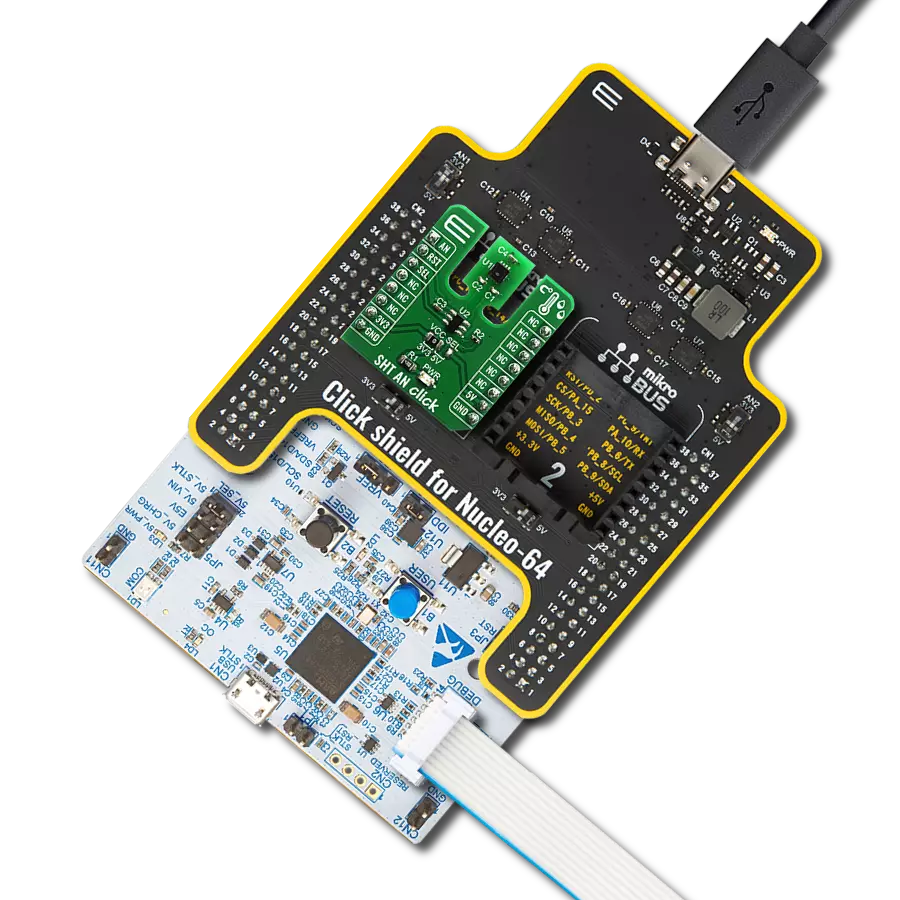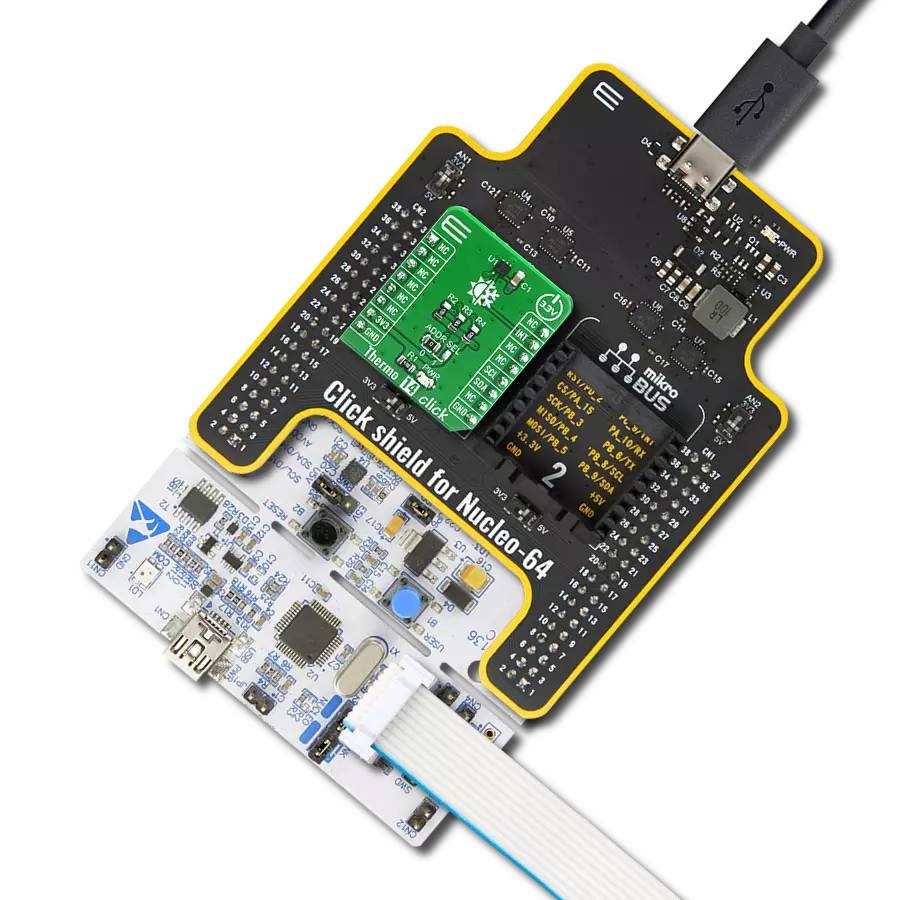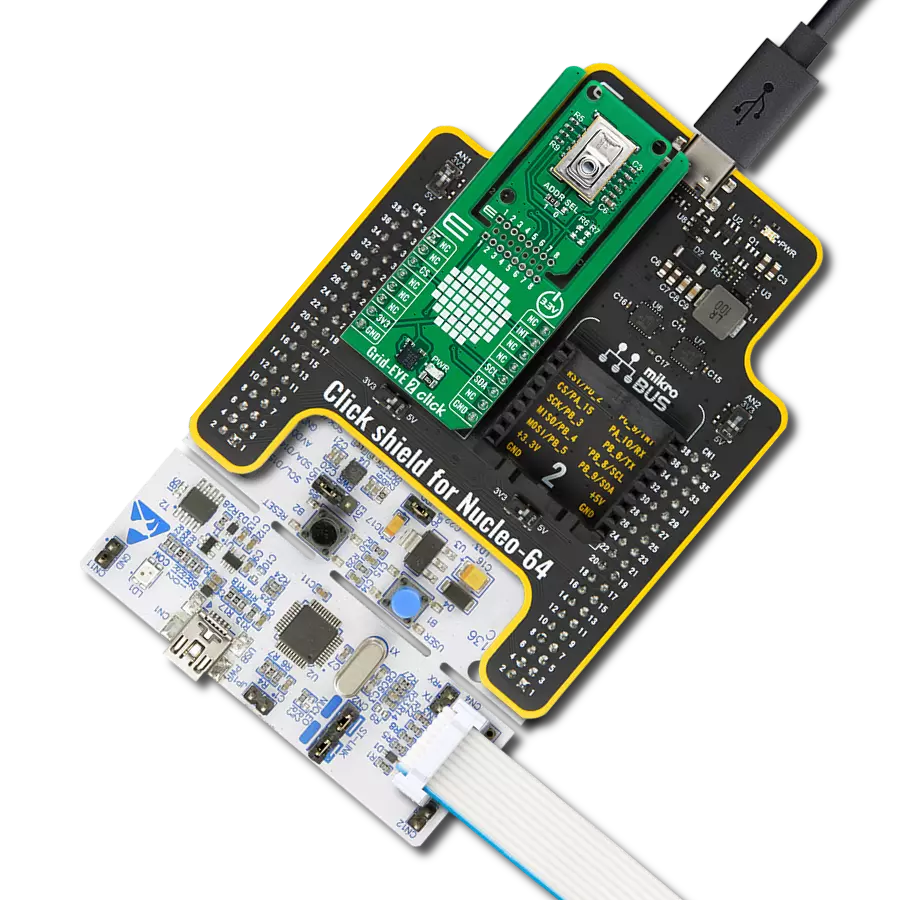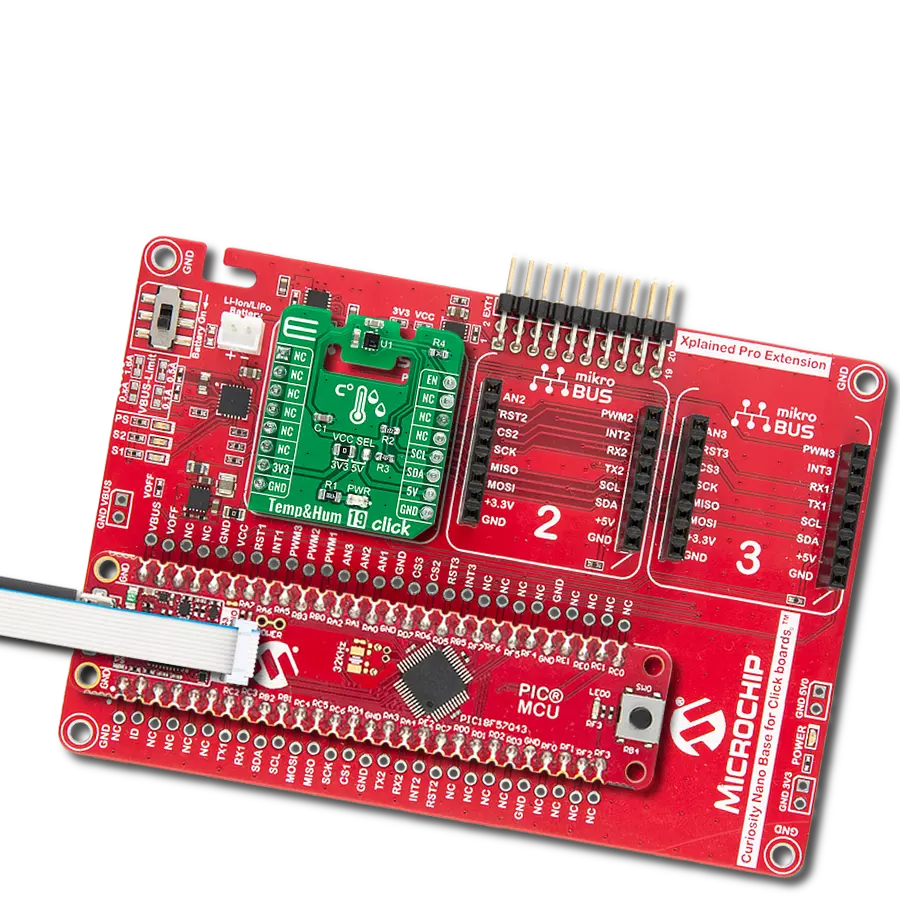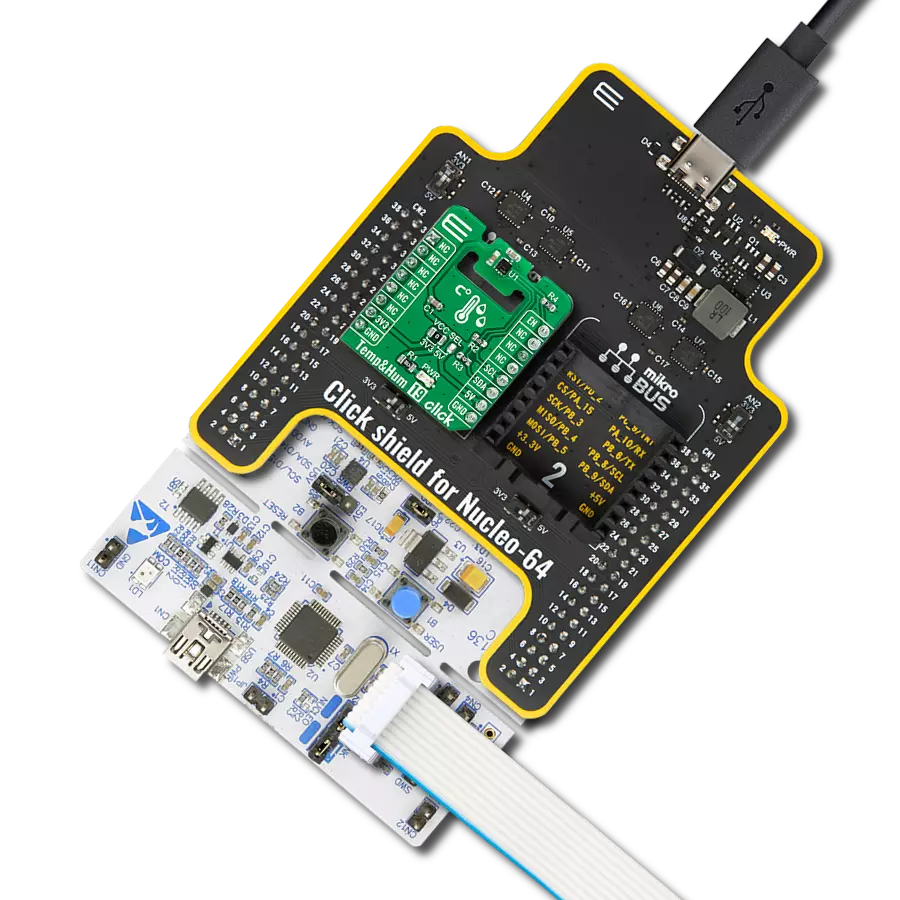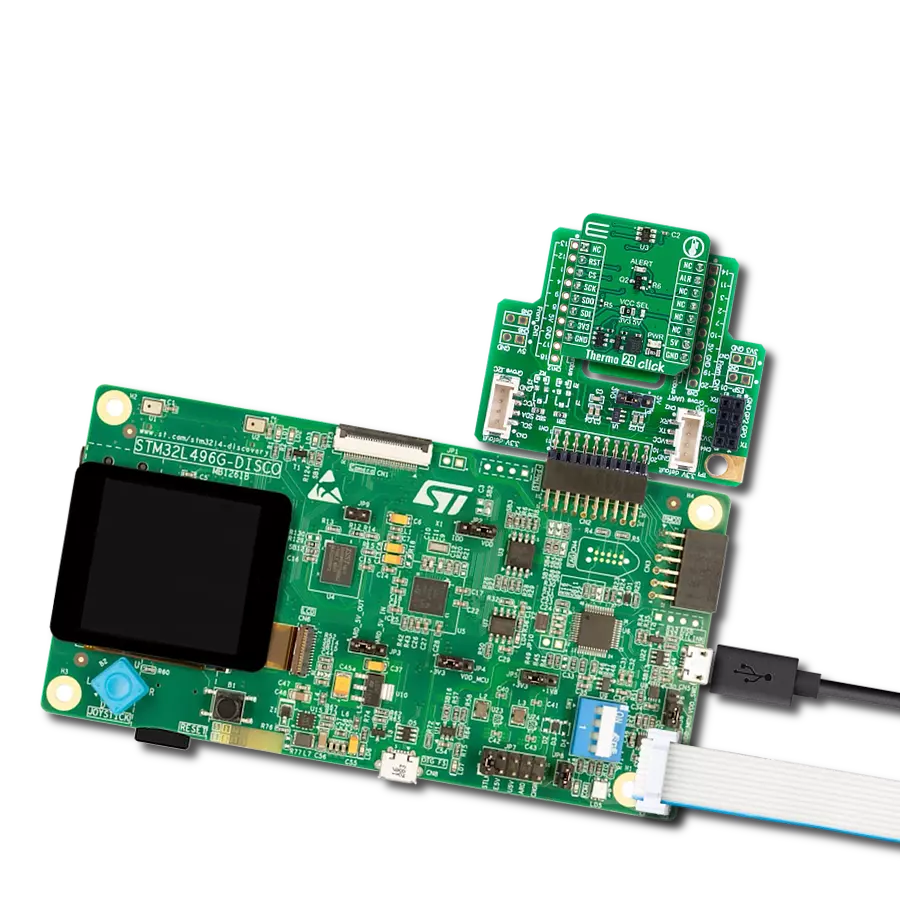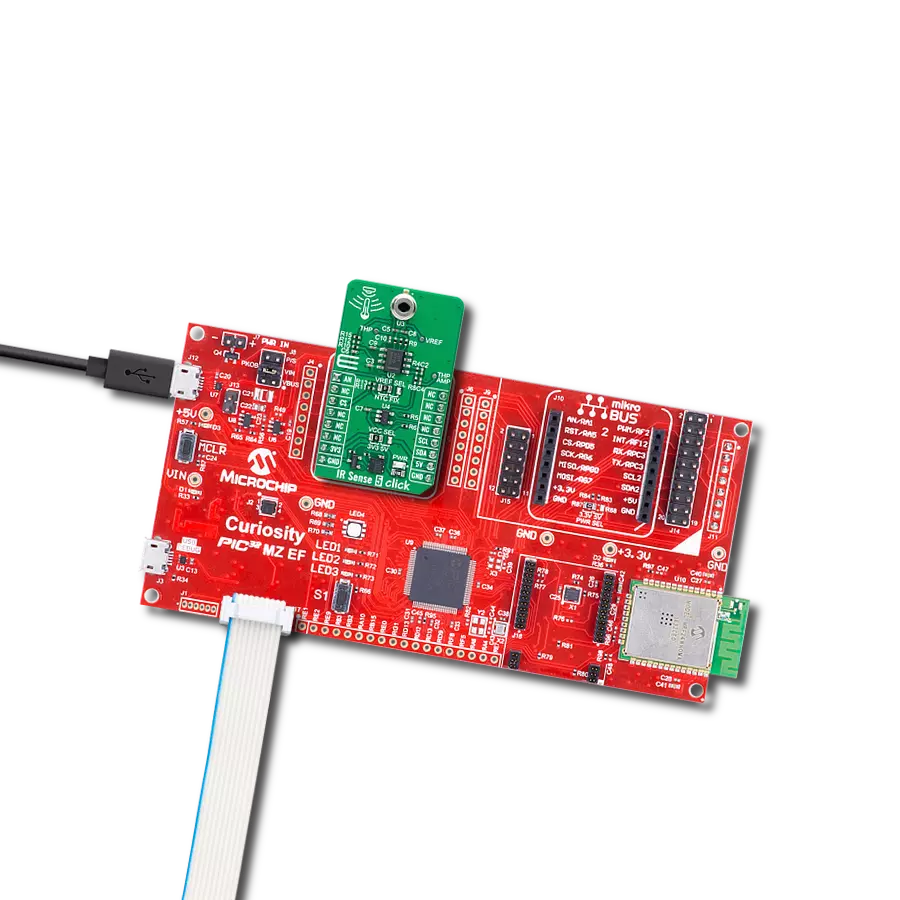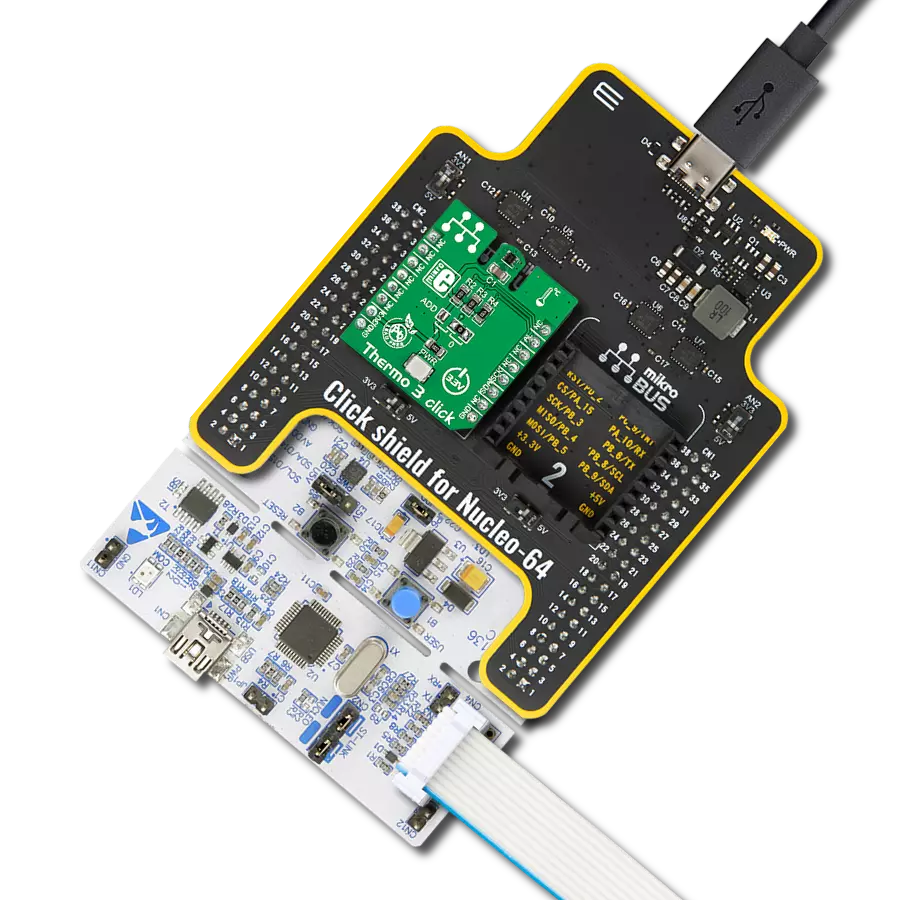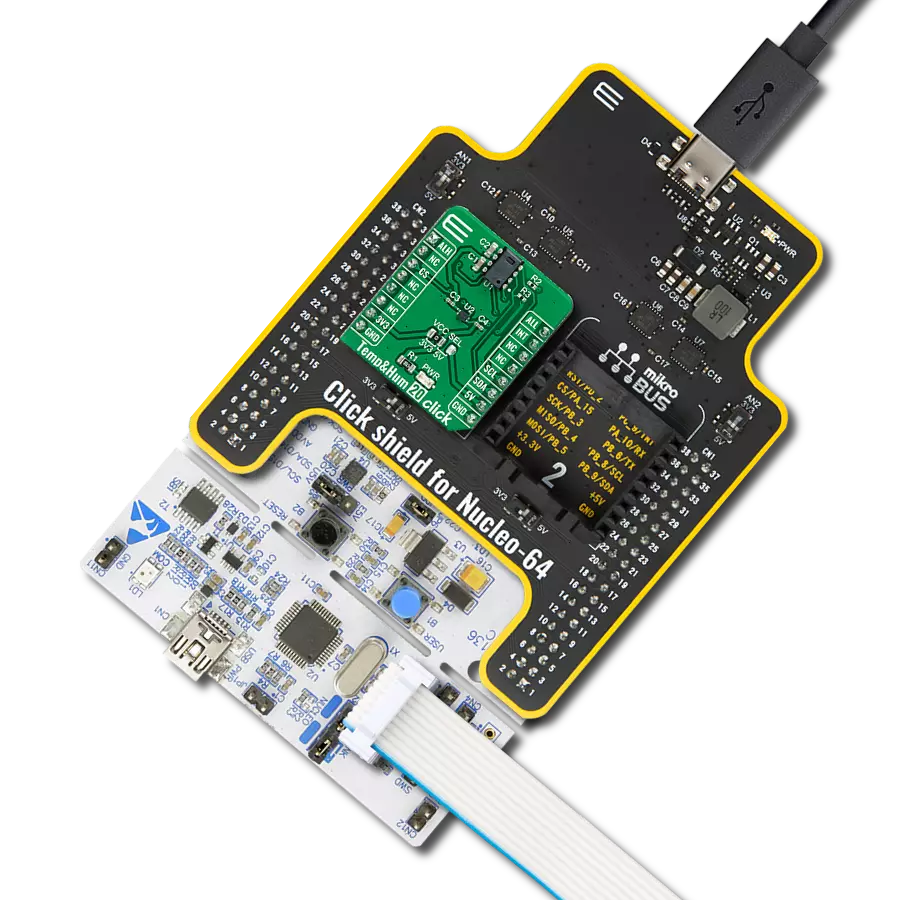Our temperature and humidity measurement solution is designed to provide you with accurate data, ensuring your comfort and well-being.
A
A
Hardware Overview
How does it work?
Temp&Hum 5 Click is based on the HIH6130, a relative humidity and temperature sensor with I2C interface from Honeywell. This sensor IC integrates two very accurate sensing components: temperature sensor, and relative humidity sensor. The HIH6130 sensor integrates the complete temperature and humidity measurement system on a chip. Each sample is factory calibrated, providing an expected performance for each unit. The measurement results are available over the I2C interface. By applying simple conversion formulas, it is possible to obtain readings in physical units, directly. These conversion formulas are given in the HIH6130 datasheet and provide readings in °C and %RH. The HIH6130 features two ALARM outputs, which are used to indicate if the RH readings have exceeded, or fallen below a certain threshold, which can be programmed by the user, over the I2C. Besides the threshold values, the HIH6130 allows setting the polarity of the signal on these pins, as well as their driving topology (push-pull or open-drain). Temp&Hum 5 click does not feature any pull-up resistors, thus allowing the user to choose the most suitable method. ALARM pins are routed to the mikroBUS™ INT and PWM pins, which are labeled as ALH and ALL on this Click board™, respectively. The HIH6130 incorporates an accurate bandgap temperature sensor, which can measure the temperature in the range between -25°C and 85°C which is suitable for most
demanding applications. The accuracy is greater if the range is narrowed down: when used over the range between 0°C and 60°C, the typical accuracy is ±0.5°C. Also, the repeatability of the temperature measurement is very good, since each sensor unit is factory-calibrated. The HIH6130 sensor IC can be reliably used for prolonged periods of time, as it has a very low thermal drift of less than 0.05°C per five-year interval. After the measurement has been converted by a high-precision 14-bit ADC, it is fed to a logic back-end which applies factory-calibrated correction and converts the raw data into a compensated value. By applying a simple conversion formula, the temperature measurement can be read directly in °C. Please note that the sensor will take some time to accommodate to the ambient temperature, especially if the temperature changes quickly, considering the thermal conductivity of the PCB itself. However, the Click board™ surface is not very large, resulting in lower thermal inertia. The humidity sensor is a laser-trimmed capacitor-based sensor which changes the capacitance proportionally to the relative humidity. However, the capacitance of this sensor is affected by changes in the ambient temperature, as well. However, the HIH6130 IC features a multilayered design which protects the sensing element from various application hazards, including condensation, dust, dirt, oils, and other environmental hazards, making it very
robust and reliable, even in harsh conditions. The datasheet of the HIH6130 offers a map of the RH accuracy at different temperatures, covering a range of different values. The RH sensor accuracy varies in the range between ±1% and ±3%, depending on the measurement conditions. This table can be used to check the exact accuracy for some specific ℃ and %RH conditions. The industry-leading long-term stability of the humidity sensor is reflected in its low drift from 0.05% to 1.2%, during a 5-year interval. After the measurement has been converted by high-precision 14-bit ADC, it is fed to a logic back-end which applies factory-calibrated correction and converts the raw data into a compensated value. By applying a simple conversion formula, the temperature measurement can be read directly in %RH. Note that capacitor-based humidity sensors commonly suffer from a small hysteresis, which may occur if the sensor is used in very humid conditions for prolonged periods of time. However, this hysteresis is not irreversible. The HIH6130 datasheet specifies that its hysteresis should stay within the range of ±1 %RH. Temp&Hum 5 click uses the I2C communication interface. It has pull-up resistors for the I2C interface, connected to a voltage level that can be selected by moving the VCC SEL jumper to an appropriate position (3.3V or 5V), allowing the Click board™ to be interfaced with a wide range of different MCUs.
Features overview
Development board
UNI Clicker is a compact development board designed as a complete solution that brings the flexibility of add-on Click boards™ to your favorite microcontroller, making it a perfect starter kit for implementing your ideas. It supports a wide range of microcontrollers, such as different ARM, PIC32, dsPIC, PIC, and AVR from various vendors like Microchip, ST, NXP, and TI (regardless of their number of pins), four mikroBUS™ sockets for Click board™ connectivity, a USB connector, LED indicators, buttons, a debugger/programmer connector, and two 26-pin headers for interfacing with external electronics. Thanks to innovative manufacturing technology, it allows you to build
gadgets with unique functionalities and features quickly. Each part of the UNI Clicker development kit contains the components necessary for the most efficient operation of the same board. In addition to the possibility of choosing the UNI Clicker programming method, using a third-party programmer or CODEGRIP/mikroProg connected to onboard JTAG/SWD header, the UNI Clicker board also includes a clean and regulated power supply module for the development kit. It provides two ways of board-powering; through the USB Type-C (USB-C) connector, where onboard voltage regulators provide the appropriate voltage levels to each component on the board, or using a Li-Po/Li
Ion battery via an onboard battery connector. All communication methods that mikroBUS™ itself supports are on this board (plus USB HOST/DEVICE), including the well-established mikroBUS™ socket, a standardized socket for the MCU card (SiBRAIN standard), and several user-configurable buttons and LED indicators. UNI Clicker is an integral part of the Mikroe ecosystem, allowing you to create a new application in minutes. Natively supported by Mikroe software tools, it covers many aspects of prototyping thanks to a considerable number of different Click boards™ (over a thousand boards), the number of which is growing every day.
Microcontroller Overview
MCU Card / MCU
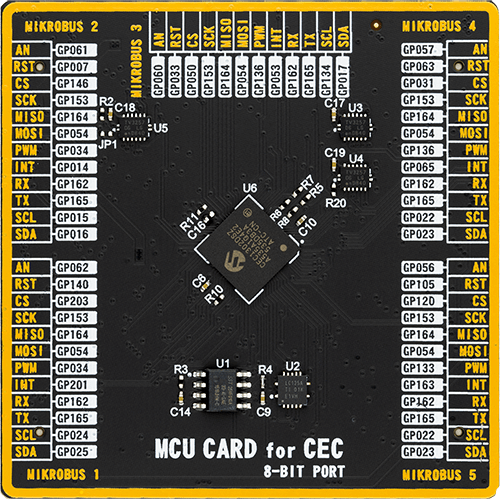
Type
8th Generation
Architecture
ARM Cortex-M4
MCU Memory (KB)
32
Silicon Vendor
Microchip
Pin count
144
RAM (Bytes)
131072
Used MCU Pins
mikroBUS™ mapper
Take a closer look
Click board™ Schematic

Step by step
Project assembly
Track your results in real time
Application Output
1. Application Output - In Debug mode, the 'Application Output' window enables real-time data monitoring, offering direct insight into execution results. Ensure proper data display by configuring the environment correctly using the provided tutorial.

2. UART Terminal - Use the UART Terminal to monitor data transmission via a USB to UART converter, allowing direct communication between the Click board™ and your development system. Configure the baud rate and other serial settings according to your project's requirements to ensure proper functionality. For step-by-step setup instructions, refer to the provided tutorial.

3. Plot Output - The Plot feature offers a powerful way to visualize real-time sensor data, enabling trend analysis, debugging, and comparison of multiple data points. To set it up correctly, follow the provided tutorial, which includes a step-by-step example of using the Plot feature to display Click board™ readings. To use the Plot feature in your code, use the function: plot(*insert_graph_name*, variable_name);. This is a general format, and it is up to the user to replace 'insert_graph_name' with the actual graph name and 'variable_name' with the parameter to be displayed.

Software Support
Library Description
This library contains API for Temp&Hum 5 Click driver.
Key functions:
temphum5_start_measurement- Functions for start measurementtemphum5_get_temperature- Functions for read Temperature datatemphum5_get_humidity- Functions for read Relative Huminidy data
Open Source
Code example
The complete application code and a ready-to-use project are available through the NECTO Studio Package Manager for direct installation in the NECTO Studio. The application code can also be found on the MIKROE GitHub account.
/*!
* \file
* \brief TempHum5 Click example
*
* # Description
* This application measures temperature and humidity.
*
* The demo application is composed of two sections :
*
* ## Application Init
* Initialization device init
*
* ## Application Task
* Reads Temperature and Humidity data and this data logs to USBUART every 1 sec.
*
* \author MikroE Team
*
*/
// ------------------------------------------------------------------- INCLUDES
#include "board.h"
#include "log.h"
#include "temphum5.h"
// ------------------------------------------------------------------ VARIABLES
static temphum5_t temphum5;
static log_t logger;
// ------------------------------------------------------ APPLICATION FUNCTIONS
void application_init ( void )
{
log_cfg_t log_cfg;
temphum5_cfg_t cfg;
/**
* Logger initialization.
* Default baud rate: 115200
* Default log level: LOG_LEVEL_DEBUG
* @note If USB_UART_RX and USB_UART_TX
* are defined as HAL_PIN_NC, you will
* need to define them manually for log to work.
* See @b LOG_MAP_USB_UART macro definition for detailed explanation.
*/
LOG_MAP_USB_UART( log_cfg );
log_init( &logger, &log_cfg );
log_info( &logger, "---- Application Init ----" );
// Click initialization.
temphum5_cfg_setup( &cfg );
TEMPHUM5_MAP_MIKROBUS( cfg, MIKROBUS_1 );
temphum5_init( &temphum5, &cfg );
}
void application_task ( )
{
float temperature;
float humidity;
temphum5_start_measurement( &temphum5 );
temperature = temphum5_get_temperature( &temphum5, TEMPHUM5_TEMP_DATA_IN_CELSIUS );
log_printf( &logger, "Temperature: %.2f C \r\n ", temperature );
humidity = temphum5_get_humidity ( &temphum5 );
log_printf( &logger, "Humidity: %.0f RH \r\n ", humidity );
log_printf( &logger, "------------------------ \r\n " );
Delay_ms ( 1000 );
}
int main ( void )
{
/* Do not remove this line or clock might not be set correctly. */
#ifdef PREINIT_SUPPORTED
preinit();
#endif
application_init( );
for ( ; ; )
{
application_task( );
}
return 0;
}
// ------------------------------------------------------------------------ END

















